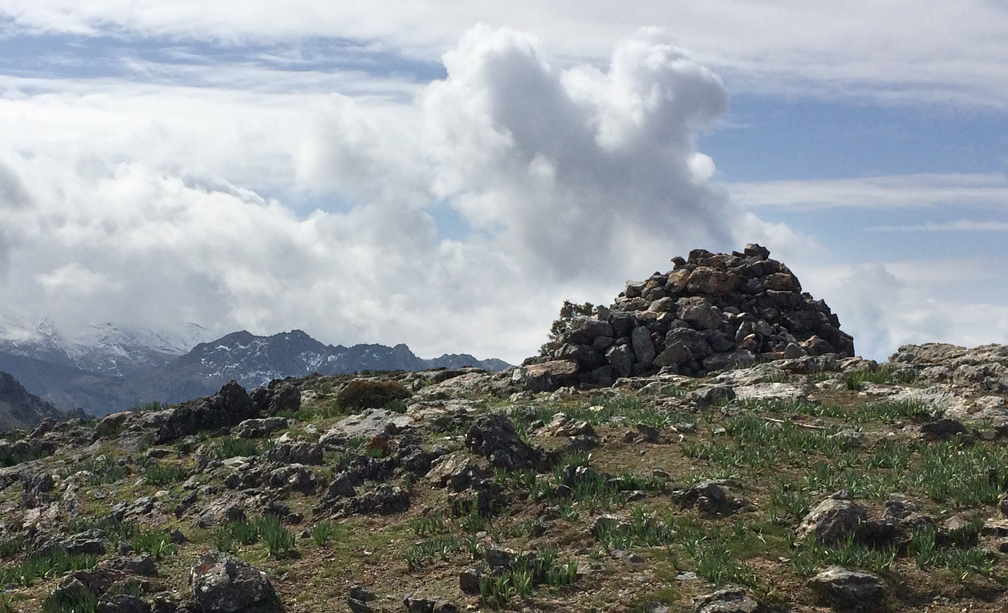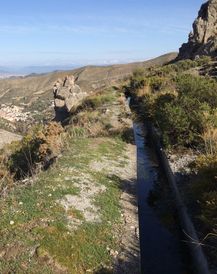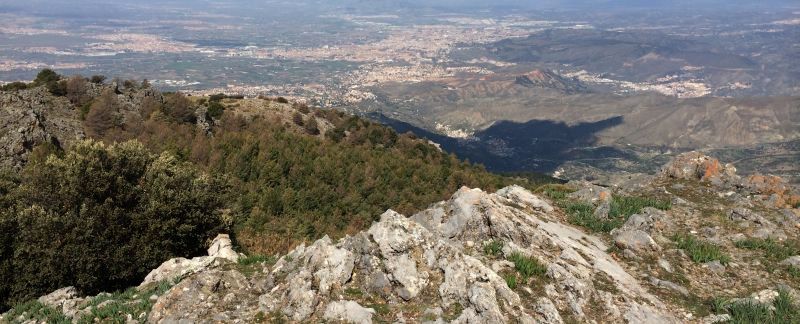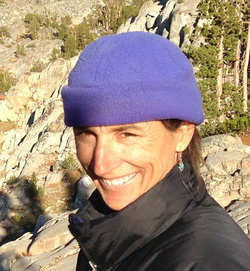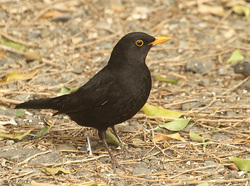
The blackbird had followed me, though, ever hopeful. I identified it as the European blackbird, Turdus merula, and opened a zip-loc with some crackers so I could drop crumbs. The bird swooped down. I wondered if I was still in Phoenicia or whether time had righted itself as soon as I left the men behind. The bird trilled. I marveled at the music, and thought of all the references to these melodic birds, and wondered if it could use the bird to pinpoint my “when”.
Ziryab, an Arabic term that translates as "blackbird", was a beloved Arabic musician. He lived in medieval Spain more than a thousand years ago, in the 800’s. He knew thousands of songs by heart, influenced the direction of music, played in the Palace of Alhambra, and designed the instrument that became the lute. The Anglo-saxon name for the blackbird was the osle, as in Shakespeare's “ouzelicock so black of hue”, scribed in A Midsummer Night's Dream in the late 1500’s. Even the Beatles drew inspiration from the bird: “Blackbird singing in the dead of night…”, in 1968. Hmmm… more than 1,200 years as a character on the stage of human drama. I wouldn’t get any help on my timeline from the blackbird.
I continued upward, through rosemary and gorse, both in bloom. The dry, rocky shrubland continued as far upwards as I could see. I heard rockfall behind me and a nasal braying. I turned. A scraggly line of kids and elderly people trudged up the trail behind me. I released a long, relieved breath as I noted they weren’t Phoenicians. They were dressed in somber grays and blacks, worn clothes, patched. Girls and old women wore skirts. The elderly men wore dark coats. Each kid was leading a mule. One mule had balked and was complaining loudly. Its feet were braced, pulling back on the boy who tried to tug it forward. Kids started throwing rocks at it. Finally the mule gave in and started walking again. The first person on the trail to reach me was an old man. His face was a spiderweb of lines and there was a hardness about his features. He looked me over suspiciously, then tread a wide circle to avoid me. The woman behind him did the same. The girl behind her started with surprise when she saw me, but gave me a cheery “Buen’ dia’!”
My face must have softened at hearing the Spanish because she continued without pause.
“?Va a ayudarno’ a plantar árbole’? (Are you going to help us plant trees?)
Vale, toma mi mula! Tengo que tirar de mi cathetine’!” (Right, take my mule! I have to pull up my socks!).
Vale, lo tengo. Por qué lleva lo’ pantalone’? (OK, now I have it. Why are you wearing pants?).
She continued to warble on in a melodious and thickly southern Spanish, swallowing her terminal “s’s”. I never thought I would welcome hearing the language so much. I stepped into line beside her and tried to follow her words. I glanced back over the line. Shawled and hatted heads were bent to climbing up the hill. I saw a boy stabilize a teetering elderly woman. Muleload after muleload, I could see hundreds of pine seedlings in burlap bags swaying to the rhythm of the mules’ steps. Great Birnam wood to high Dunsinane hill Shall come, I mouthed silently from MacBeth.
In my own version of Spanish, I asked the girl why they were planting trees. She laughed at my accent and my words, but was happy enough to tell me they got paid to do it. She’d been doing it every day all spring. Except for Sunday, of course. All the kids did it, and most of the viejos. Because they needed the money. Brayan was the fastest planter, and got paid the most, but he split what he made with his grandfather who was really slow. Maria Jose said they should all take more care planting, otherwise the seedlings would die. She gave all her money to her husband.
“Who pays you?” I interrupted.
“Stop talking to her”, the old man turned around and growled. I put my hands up in surrender and stepped out of the line.
“The government”, the girl whispered under her breath as she trudged past. An elderly woman stopped next to me, breathing hard. She looked at me appraisingly. Her eyes were somber.
“Are you one of Franco’s spies?” she asked matter-of-factly. “Are you?”
“Definitely not”. I shook my head. But now I had my pin in the timeline. Franco? Somewhere between 1939, the end of the civil war when Franco took power and 1975, when Franco died. Whew. At least I was getting within spitting distance of my own era.
“No one talks, but we all know who kills who,” the woman nodded sagely. “My son died last year.”
I gulped. “I’m so sorry,” I said lamely.
“I’ve been to Granada three times in my life, you know. Granada three times, but never to Madrid. But you have, haven’t you? Look at you. A woman in pants.” She spat on the ground. “You can tell Franco in Madrid that I know who killed my son.”
A shiver crept up my spine. I felt my nape hairs rise. “I don’t work for Franco,” I said again. And pulled myself away from the woman. From the whole line, in fact. I turned and ran away across a slope, pounding upwards, always upwards, aiming for the summit.
The young girl waved. I didn’t wave back.
Heaving with effort, I pulled myself behind a rock, sat down and covered my face with my hands. I shivered again. That girl could still be alive, I thought. In Monachil. She’d be in her 70’s or 80’s. What had happened here? What had Franco done to these people? Turned brother against brother, friend against friend, neighbor against neighbor. Will the people ever forgive each other? The chasm of Los Cohorros is nothing compared to what Franco had done to this place.
I waited for my heart to stop racing. I heard a familiar chirrup. I peeked out from behind my rock. The blackbird was hopping among the branches of a low rosemary, cocking its head sideways, looking for insects. I looked beyond it to where the line of tree-planters and their mules had been. They were gone. I breathed. And scattered crumbs for the bird.
When was I?
I stood up and brushed myself off. I headed for a trail above me, snaking through a forest of pine, a plantation that must be at least 50 years old. The trail was wooded. Here was a sign saying Cerro Huenes was 1.2 km further. I tugged out my map, but the trail didn’t go to the summit. I could see the peak above me. So, I left the trail, and struck out upward and out of the forest, toward the bare knoll way above me. Maybe I wasn't following a trail, but dozens of trails criss-crossed the hill sideways – goats, sheep maybe. Some looked more used than others. Perhaps humans used them as well, but certainly not to reach the summit. I nearly tripped over a pile of firewood, sawed neatly and stacked carefully. I heard a chainsaw whining somewhere nearby, then watched a small pine below me topple. A man in wellies saw me watching him and doffed his cap. I waved enthusiastically. I’d never been happier to see a chainsaw.
I huffed myself up onto the summit plateau and saw the pile of rocks that marked the highest point. The blackbird has gotten there before me and is perched on the highest stone. I step onto the pile and look around. The bird flies off and away toward the east, where the Sierra Nevada are a crenelated horizon, with new snow from the recent storms exaggerating the topography. To the west below me, the rooftops of distant Granada fill a broad valley, in some places overflowing the basin to wash up the slopes of the surrounding hills. Monachil is there below me. And somewhere among those small-town buildings, the school. And that’s where I’ll meet Coby, who will be finishing his last class in just a little over an hour. I hope.
Ziryab, an Arabic term that translates as "blackbird", was a beloved Arabic musician. He lived in medieval Spain more than a thousand years ago, in the 800’s. He knew thousands of songs by heart, influenced the direction of music, played in the Palace of Alhambra, and designed the instrument that became the lute. The Anglo-saxon name for the blackbird was the osle, as in Shakespeare's “ouzelicock so black of hue”, scribed in A Midsummer Night's Dream in the late 1500’s. Even the Beatles drew inspiration from the bird: “Blackbird singing in the dead of night…”, in 1968. Hmmm… more than 1,200 years as a character on the stage of human drama. I wouldn’t get any help on my timeline from the blackbird.
I continued upward, through rosemary and gorse, both in bloom. The dry, rocky shrubland continued as far upwards as I could see. I heard rockfall behind me and a nasal braying. I turned. A scraggly line of kids and elderly people trudged up the trail behind me. I released a long, relieved breath as I noted they weren’t Phoenicians. They were dressed in somber grays and blacks, worn clothes, patched. Girls and old women wore skirts. The elderly men wore dark coats. Each kid was leading a mule. One mule had balked and was complaining loudly. Its feet were braced, pulling back on the boy who tried to tug it forward. Kids started throwing rocks at it. Finally the mule gave in and started walking again. The first person on the trail to reach me was an old man. His face was a spiderweb of lines and there was a hardness about his features. He looked me over suspiciously, then tread a wide circle to avoid me. The woman behind him did the same. The girl behind her started with surprise when she saw me, but gave me a cheery “Buen’ dia’!”
My face must have softened at hearing the Spanish because she continued without pause.
“?Va a ayudarno’ a plantar árbole’? (Are you going to help us plant trees?)
Vale, toma mi mula! Tengo que tirar de mi cathetine’!” (Right, take my mule! I have to pull up my socks!).
Vale, lo tengo. Por qué lleva lo’ pantalone’? (OK, now I have it. Why are you wearing pants?).
She continued to warble on in a melodious and thickly southern Spanish, swallowing her terminal “s’s”. I never thought I would welcome hearing the language so much. I stepped into line beside her and tried to follow her words. I glanced back over the line. Shawled and hatted heads were bent to climbing up the hill. I saw a boy stabilize a teetering elderly woman. Muleload after muleload, I could see hundreds of pine seedlings in burlap bags swaying to the rhythm of the mules’ steps. Great Birnam wood to high Dunsinane hill Shall come, I mouthed silently from MacBeth.
In my own version of Spanish, I asked the girl why they were planting trees. She laughed at my accent and my words, but was happy enough to tell me they got paid to do it. She’d been doing it every day all spring. Except for Sunday, of course. All the kids did it, and most of the viejos. Because they needed the money. Brayan was the fastest planter, and got paid the most, but he split what he made with his grandfather who was really slow. Maria Jose said they should all take more care planting, otherwise the seedlings would die. She gave all her money to her husband.
“Who pays you?” I interrupted.
“Stop talking to her”, the old man turned around and growled. I put my hands up in surrender and stepped out of the line.
“The government”, the girl whispered under her breath as she trudged past. An elderly woman stopped next to me, breathing hard. She looked at me appraisingly. Her eyes were somber.
“Are you one of Franco’s spies?” she asked matter-of-factly. “Are you?”
“Definitely not”. I shook my head. But now I had my pin in the timeline. Franco? Somewhere between 1939, the end of the civil war when Franco took power and 1975, when Franco died. Whew. At least I was getting within spitting distance of my own era.
“No one talks, but we all know who kills who,” the woman nodded sagely. “My son died last year.”
I gulped. “I’m so sorry,” I said lamely.
“I’ve been to Granada three times in my life, you know. Granada three times, but never to Madrid. But you have, haven’t you? Look at you. A woman in pants.” She spat on the ground. “You can tell Franco in Madrid that I know who killed my son.”
A shiver crept up my spine. I felt my nape hairs rise. “I don’t work for Franco,” I said again. And pulled myself away from the woman. From the whole line, in fact. I turned and ran away across a slope, pounding upwards, always upwards, aiming for the summit.
The young girl waved. I didn’t wave back.
Heaving with effort, I pulled myself behind a rock, sat down and covered my face with my hands. I shivered again. That girl could still be alive, I thought. In Monachil. She’d be in her 70’s or 80’s. What had happened here? What had Franco done to these people? Turned brother against brother, friend against friend, neighbor against neighbor. Will the people ever forgive each other? The chasm of Los Cohorros is nothing compared to what Franco had done to this place.
I waited for my heart to stop racing. I heard a familiar chirrup. I peeked out from behind my rock. The blackbird was hopping among the branches of a low rosemary, cocking its head sideways, looking for insects. I looked beyond it to where the line of tree-planters and their mules had been. They were gone. I breathed. And scattered crumbs for the bird.
When was I?
I stood up and brushed myself off. I headed for a trail above me, snaking through a forest of pine, a plantation that must be at least 50 years old. The trail was wooded. Here was a sign saying Cerro Huenes was 1.2 km further. I tugged out my map, but the trail didn’t go to the summit. I could see the peak above me. So, I left the trail, and struck out upward and out of the forest, toward the bare knoll way above me. Maybe I wasn't following a trail, but dozens of trails criss-crossed the hill sideways – goats, sheep maybe. Some looked more used than others. Perhaps humans used them as well, but certainly not to reach the summit. I nearly tripped over a pile of firewood, sawed neatly and stacked carefully. I heard a chainsaw whining somewhere nearby, then watched a small pine below me topple. A man in wellies saw me watching him and doffed his cap. I waved enthusiastically. I’d never been happier to see a chainsaw.
I huffed myself up onto the summit plateau and saw the pile of rocks that marked the highest point. The blackbird has gotten there before me and is perched on the highest stone. I step onto the pile and look around. The bird flies off and away toward the east, where the Sierra Nevada are a crenelated horizon, with new snow from the recent storms exaggerating the topography. To the west below me, the rooftops of distant Granada fill a broad valley, in some places overflowing the basin to wash up the slopes of the surrounding hills. Monachil is there below me. And somewhere among those small-town buildings, the school. And that’s where I’ll meet Coby, who will be finishing his last class in just a little over an hour. I hope.
